“I am proud”, Says Former S-21 Photographer About His Work
Today, witness Nhem En – former S-21 photographer – continued his testimony. He told the Court about his time at Tuol Sleng, his time as a messenger prior to that, and briefly spoke about photographs and other documents that he held in possession today that he could make available to the court. He also gave evidence as to the tasks of other cadres.
Doubts about duties of witness
All parties were present, with Nuon Chea following the hearing from the holding cell. The reserve witness was 2-TCW-865. The Chamber had received the book authored by the witness. The book was distributed by the court officer to all parties. The President reminded the defense teams that they had only one session left. Nuon Chea Defense Counsel Victor Koppe said that they had only started questioning the witness at 3.15 pm yesterday. He suggested to grant them another half an hour after this session. This was supported by Khieu Samphan Defense Counsel Anta Guissé.
Mr. Koppe then started his questioning. He confronted the witness with the statement of head of photographers Kim Sreang.[1] Another witness – Suos Thy – had said that he had never heard of his name, and Duch had said that Nhem En was the son of a staff member and never allowed to take photos at S-21.[2]
As for Sreang, he said that he started working at S-21 in late July 1976. He knew the second witness and said that this person had worked in the administrative section. He said that Duch had the right not to know him. “I was mature enough to know what was right and what was wrong”. Not only Duch worked there, he said, but also many other people. When Mr. Koppe asked whether it was therefore wrong that he had only a minimal role in taking photos, he replied that his main task was to take photographs and drawing maps.
Prey Sar and photographs
Mr. Koppe then turned to Prey Sar. He had said that he “used to go to Prey Sar” and take photos there. Mr. Koppe asked whether this was correct. He went to Prey Sar on a weekly trip.
Mr. Koppe read an excerpt of Nhim Kim Sreang, who had talked about Prey Sar.[3] The witness replied that it was correct. There was a person called Huy in his section, but it was a different Huy to the ones working at the security section. People who were sent to Prey Sar were photographed in Phnom Penh. Mr. Koppe referred to another excerpt of the same interview, in which Nhim Kim Sreang had talked about prisoners who were taken to the rice fields to take photographs.[4] The witness replied that prisoners were executed after their photographs were taken if they were not important. This took place in the surrounding of Tuol Sleng in the beginning, but since the area was full later, they were executed in the rice fields.
Mr. Koppe referred to the witness’s book, in which he had talked about the “dark room”. Judge Claudia Fenz interrupted Mr. Koppe’s examination and said that a ruling had to be made on the book now, since he started using it. The Co-Prosecutors and Khieu Samphan Defense Team had no objection, while International Civil Party Lead Co-Lawyer Marie Guiraud said that they had not had the opportunity to look at the book yet. The book was admitted.
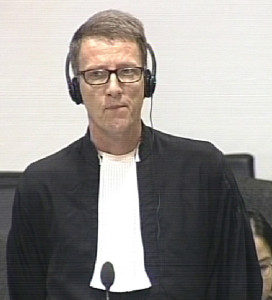
International Nuon Chea Defense Counsel Victor Koppe
Mr. Koppe asked the witness where exactly the films were developed. The witness replied that he had various cameras that could also be seen in the book. They were developed in a house outside. He replied that it was around fifty meters away from the canal. When the witness elaborated further, the President interrupted him and instructed him to give short answers. He could not recall the street number or house number. Mr. Koppe asked whether it was street 350 or 360, which the witness did not know. Mr. Koppe asked whether all the negatives of the photographs that had been taken at S-21 were stored there. He replied that the six photographers kept the film rolls and negatives.
Mr. Koppe requested leave to present the witness with the still of yesterday’s documentary Die Angkar.[5] The still showed several negatives. The witness confirmed that these negatives were from a good camera and used at S-21.
Mr. Koppe moved on and asked whether it was correct that he and Duch were one of the last ones to escape when the Vietnamese arrived on January 7 1979. The witness confirmed this and said that it was liberated at noon time, and they left through the Chinese embassy at 3 pm. He did not have any belongings with him when he left Phnom Penh, except a golden pen and a rifle. This prompted Mr. Koppe to ask how he got into possession of these cameras that he had said were used at S-21 if he did not take anything with him. He replied that he buried it in the ground. He could only find the items at one location when he returned, while he had buried it in two places.
Mr. Koppe wanted to know whether the witness was in a position to explain why only around 5,000 negatives were found of Tuol Sleng. He asked where, if it was correct that there were around 12,000 prisoners at S-21, the other 7,000 negatives were. The witness said that it was true what Mr. Koppe had said. The negatives had been taken by photographers. He guessed that Duch might have taken them.
Mr. Koppe asked whether it was correct that 2,000 or 3,000 prisoners were photographed as estimated by another witness. At this point, Senior Assistant Prosecutor Dale Lysak objected and asked for references. He said that his recollection was that the witness had said that the witness had said that these were the photographs he had taken himself. Mr. Koppe gave the references, but rephrased the question.[6] The witness said that this was not true, since the number of negatives was much larger. As a final question, Mr. Koppe asked whether it was possible that only 5,000 people were detained at S-21 and possibly executed. Mr. Lysak said that references needed to be given, and if not, he would object.
Mr. Koppe said that he found the information about 5,000 detainees in Chandler and the Geng Biao Report (which had been discussed with Elizabeth Becker) and that there were 5,000 negatives “literally everywhere in the case file”. Judge Fenz said that this was clearly not sufficient as references. After a brief discussion, Mr. Koppe withdrew the question.
Tasks of the witness and Democratic Kampuchea leadership
The floor was granted to the Co-Prosecution. Mr. Lysak asked how old he was when the Khmer Rouge first provided him with a gun. He said that he joined the revolution in 1971 and carried a gun at that time. Mr. Lysak inquired whether all children in his unit had guns. Mr. En replied that his gun was “perhaps from Germany or another country”. He received it from the North-Vietnamese troops. Rifles were provided to thirty people in his group. The rifles were sent from Kampong Thom.
Mr. Lysak referred to his Written Record of Interview, in which he had talked about his trip to China.[7] Next, Mr. Lysak referred to his original Written Record of Interview of 2002.[8] In this interview, he had talked about having worked near Monivong hospital for around three months during “the windy season”, so perhaps in November or December.
Asked about his relation to high-ranking cadres, he said that he was “busy taking photographs with important people”, but did not see Khieu Samphan very often. Asked about his trips to provinces to take other photos, he replied that his main task was to take photographs at Tuol Sleng. He would be sent elsewhere sometimes once a month and sometimes once every two months. This depended on visits from other delegations, such as delegations from Yugoslavia. “I have documents to proof this”, he said. Some of them were used for magazines.
Next, Mr. Lysak requested leave to present a monthly magazine to the witness, which was granted.[9] He asked whether he remembered this monthly magazine. He remembered the document and said that 80% of the photographs were his. The magazine was printed near the Central Market. Hu Nim was in charge of propaganda at the time and Ieng Thirith was responsible for social affairs. At this point, the President adjourned the hearing for a break.
After the break, the President had announced that he had ordered the court officer to collect the photographs that the witness had been given earlier. The floor was granted to the Co-Prosecution again.
He went with Ieng Sary, Son Sen, Pol Pot and Nuon Chea when he took photos at worksites and dams. With Nuon Chea he visited Kamping Puoy and Kampong Chhnang. He had photographs of Nuon Chea at this dam in his collection in Siem Reap. He went with him to district and zone committee meetings. There were around 300 photographs, but some of them had been lost. He rarely saw Khieu Samphan.
Mr. Lysak referred to his testimony, in which he had talked about meeting Khieu Samphan in the provinces.[10] He only saw Khieu Samphan one time in a meeting at the Assembly and meetings at the troops. He rarely saw him involved in local affairs. In the meeting “nothing was discussed”, but progress in the country and invasions by neighboring country mentioned. An agricultural plan was also discussed. There were many leaders there, but he could not recall them all. He had a photo of when Khieu Samphan was addressing the crowd. There were not many photographs of Khieu Samphan during Democratic Kampuchea.
Visits of worksites
When he went to Trapeang Thma, there was Ruos Nhim. Nat, Son Sen and other advisor experts were with them. Mr. Lysak referred to a statement which indicated that Khieu Samphan was present on a trip to Trapeang Thma Dam.[11] The witness said that there were six photographers. He went there three times, but never with Khieu Samphan and Nuon Chea. There was a dam that was called the 6th January Dam and one called the 30th September Dam.
Mr. Lysak showed two photos to the witness and wanted to know whether he recognized the location and whether he had taken them.[12] The witness showed one photo and said that it was taken on the 6th January Dam.[13] The second one he “may have some confusion of photos that I did not take”.
He said that Laotian, Burmese and Thai delegations were at the dams. Sometimes his team members went there and not himself.
Mr. Lysak referred to radio broadcasts that talked about the visit of Chen Yung-Kuei (Chen Yonggui) to the dams.[14] The witness recounted that Chen Yung-Kuei was a specialist in growing rice. He went with Ieng Sary, Pol Pot and others on a trip with them. He had that photo at home. They visited a location for a brief period of time, but spent a lot of time in Angkor Wat.
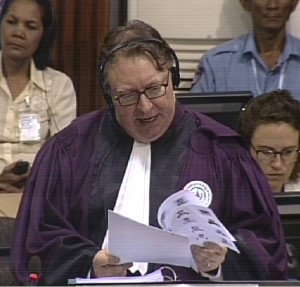
Senior Assistant Prosecutor Dale Lysak
At the time of meetings, he was 17 or 18 years old. Mr. Lysak inquired whether he took photos of an anniversary, which the witness confirmed. He took “a lot of photos”, particularly in secret meetings and meetings of assemblies. Mr. Lysak said there was evidence of Nuon Chea speeking on the 9th anniversary of the Revolutionary Army on 16 January 1977.[15] He answered that there were soldiers from more than ten divisions at the Olympic Stadium to listen to the speeches by Son Sen, Nuon Chea and Pol Pot.
Angkar had planned to eliminate CIA agents, the Russian agents, the yuon agents who intended to swallow the territory and lastly the infiltrated enemies. There was no legal representation or process, but Angkar had to eliminate these people. He had heard Pol Pot speak about this at the Olympic Stadium and through radio broadcasts. After the purges had been conducted throughout the country, the Southwest cadres came to replace the purged cadres. This also happened to cadres from Division 703. Mr. Lysak referred to Mr. En’s interview, in which he had said that the regime was cruel and that there were no investigations made before arresting someone and that people were arrested for minor mistakes or even without someone having made a mistake. He referred to “summary justice”.[16] Mr. En said that the purges were unjust for the people at Tuol Sleng and the Cambodian people living under the regime, since only around 100 people at Tuol Sleng might have been actually guilty.
Taking photographs
There were two parts of the photographic process. First, prisoners were brought in on trucks. There were two main compounds at Tuol Sleng. They would be photographed after their blindfold was taken down inside the building and before this outside on the compound.
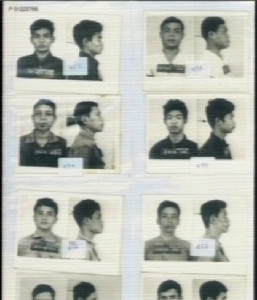
Photographs shown at the Court.
Mr. Lysak asked him to look at several photos and asked him where these were taken, since they had scattered background.[17] He replied that usually photos were taken in front of a white wall. The handwriting on them belonged to Ta Sreang. Usually the writing would be done in a book and sent to Suos Thy. Some of the photos were sent to Duch. He recounted that they had telephones in every office. When the phone rang, he would go and see the prisoners “and 100% of them would be handcuffed and blindfolded, except women”. They would then be photographed before sending to another building. They could not talk to the prisoners.
He looked at the biography of Ta Ching, who was accused of having committed a moral offence in District 16 (Kampong Leang). Mr. En’s older brother Morn was also part of the district committee. When the chief was arrested, the deputy was also arrested. This was the only prisoner he talked to. Mr. Lysak referred to page 44 and wanted to know whether this was one of the chiefs of Kampong Leang or the woman the chief had fallen in love with. He replied that it was the photo of Yeay Marn, who was a military commander in Sector 31. She got injured and one of her left breasts was removed. She was arrested on the allegation that she had an affair. The person she allegedly had an affair with was a chief of district.
Mr. Koppe interjected and said that the photos had not been admitted. Mr. Lysak asked the Chamber to add the photographs to those that had been admitted already.[18] Since there were no objections, the request was granted.
Mr. En recounted that when prisoners arrived by trucks, the photographers did not interact with them. They would be numbered according to the time that they arrived per day. The number could run into 600 or 700. This number showed the number of prisoners that arrived. The number would start at one and return to number one the next day. For this reason numbers would exist several times. At this point, the President adjourned the hearing for a break.
Oral rulings
After the break, the President issued a ruling on the request by the Co-Prosecutors in relation to Kong Sam Onn. He had been a duty counsel for witnesses 2-TCW-898, 931, 906 and 816. The Chamber rejected the requests in relation to seeking a written waiver from Khieu Samphan. International counsel Anta Guissé should question the witnesses in question.
As for protective measures of 2-TCW-865, he said that protective measures had been granted in Case 001.[19] WESU had recommended to put in practice protective measures now as well. According to Internal Rule 29, the Chamber decided on the following
- the image and voice not be made available to public
- no information related to family, contact and spouse, children and work address shall be disclosed to the public
- all information related to the location of residence shall be redacted
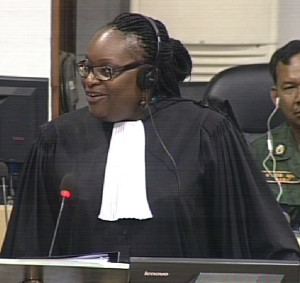
International Khieu Samphan Defense Counsel Anta Guissé
The Chamber ordered that face and voice shall be distorted and ordered media not to publish any photograph of the witness, even if they had done so previously.
Detainees at S-21
The floor was granted to the Co-Prosecution. Mr. Lysak showed to photographs to the witness.[20] Mr. Lysak said that there were two numbers on the photo of the woman. Moreover, individuals 454 and 457 had full name tags and the number of them. Mr. Lysak inquired whether the procedure for taking photographs change at some point. He replied that they had their own procedures back then. Number two referred to the sequence number. At a later stage, the number and dates were used to be tagged on the photograph. The tags were made by the photographer under the order of Duch. Mr. Lysak then wanted to know whether there were prisoners who looked like they had been beaten, since it seemed like this was the case with numbers 454 and 457. Mr. En confirmed this. He also confirmed that some children had also been brought into the center and had to be taken photographs of. Most of them were children of high officials, but some of them did not have their photographs taken. Mr. Lysak showed a few more photographs and asked whether Mr. En recalled these as photographs been taken at S-21, which the witness confirmed.[21] Mr. Lysak pointed to a picture of a mother with her child with the number 246 as a tag.[22] The witness confirmed that she was the 246th person to be taken a photograph of on the day. The witness recounted that children or infants, “almost all of them were killed, and only a few survived. Sometimes the mother and infants were separated from one another and the infants were killed.” Some entire families were brought in. After a while of having been detained at the center, “they could not escape the killing.” Moreover, “some babies who were still breastfed by their mothers were also brought in with their parents”. Mr. Koppe interjected and said that there was a lot of evidence showing that children were sent to Prey Sar and that they should at least ask for the source of his knowledge. The witness replied that the children were killed, and even those who were sent to Prey Sar were also killed. The children were transported to “perhaps Prey Sar” and to his guess they had been killed, because they never saw them again.
The President reminded Mr. En to give concise answers and only testify to what he had seen or heard and not to speculate.
Mr. Lysak wanted to know whether he saw any daycare centers were the children were kept at his weekly trips to Prey Sar. Mr. En replied that he did not know where the children were kept.
Mr. Lysak asked whether he ever witnessed Vietnamese soldiers who were still wearing their uniforms. Mr. En answered that when there was fighting between Vietnam and Cambodia, Vietnamese soldiers would be sent to Tuol Sleng. They were still in their uniforms.
Next, Mr. Lysak showed the witness another set of photographs.[23] The witness said that this showed a Vietnamese soldier. Mr. Lysak showed another photograph.[24] The witness said that this photo showed a marriage ceremony. It was Huy Sre and his wife. He was a staff member of the administrative section at Tuol Sleng. Duch arranged their marriage. Ta Hor and Ta Huy were also arranged to be married there.
Vehicles
The floor was then granted to the Civil Party lawyers. Civil Party lawyer Sam Sokon asked who assigned him to work at S-21 after he returned from his study trip in China. He replied that it was the Minister of Defense Son Sen and Lorn Nat, general staff director, and Phin.
The archival group was also divided into several subsections. The vehicles were camouflaged with a hospital sign. There were also special vehicles belonging to the CT messenger group. “Everyone was fearful when they saw these special vehicles.” The trucks were all in military colors. Sometimes people were brought in by busses, but that was rare. He sometimes saw the trucks brining the people in. Mr. Sokon wanted to know what the activities were of the prison guards to guard the prisoners. Mr. En replied that he knew “S-21 staff very clearly”. They had received fighting training, such as karate. They learned it through various “Japanese and Thai movies”.
A group of messengers sent documents to Pol Pot. When documents were brought back with writing of a red pen, they would be killed usually.
When there were rallies, the dignitaries were Pol Pot, Nuon Chea and Son Sen. He would usually see Son Sen. Pol Pot usually spoke about upholding the integrity of the country. The first trip was made in late 1976. The second was when he went to make a movie from Siem Reap to Trapeang Thma Dam. In 1978, the third trip was made. Some of the photographs were included in the magazine. They were offered food and coconut juice when they arrived. They were dressed “rather nicely”, but “I believed that it was a façade”.
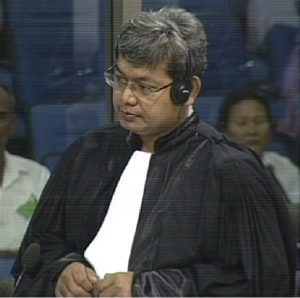
National Civil Party Lead Co-Lawyer Pich Ang
The floor was then granted to National Civil Party Lead Co-Lawyer Pich Ang. He asked about the vehicles at S-21. The witness replied that he saw jeeps and land rovers that brought in important witnesses. There were around 20 cars in total. These were used only by S-21. They were used on a vehicle on a daily basis, but sometimes only around one or two. Phao was a medic who provided treatment to both staff and prisoners. He was killed on the order of Duch later on the accusation of being a CIA agent. There was no treatment for prisoners, unless they were beaten during interrogations and had not died yet.
Turning to the next topic, Mr. Ang inquired about marriage. Mr. Ang said that in his book on page 32, there was a photo of a reception. The witness recounted that the wedding reception was held in Duch’s house. Song and the witness took a photograph of the reception. The wife of Huy Sre was called Khoeun and was ordered to marry him. Huy was a military commander. Khoeun was not happy with the marriage, but had no choice. It was a forced marriage. “Nobody could make an objection”. The Chamber reminded the witness not to speculate. Mr. Ang asked whether it was correct that he had met Khoeun, who told him that she was not happy with the marriage. Mr. En confirmed this. He only knew this couple. He did not know whether they consented to the marriage, but Angkar had required them to marry.
At this point, the President adjourned the hearing for a break.
Questions by the bench
After the break, the President first observed that Mr. Koppe had requested to have additional time to question the witness. Ms. Guissé said that there might be a need for extra time, but that was not known yet. The floor was handed to Judge Jean-Marc Lavergne, who inquired about the documents that were in the possession of the witness. Mr. En replied that he had his notebook of China with him, the photographs that he took, and the cameras. He did not have any negatives, however. They are stored in his house in Siem Reap. He also had “thousands of Khmer Rouge songs”. He did not have any minutes of meetings, but “may have voices of Pol Pot and videos of meetings, videos of Ta Mok for instance”. He had around thousand photographs and around 500 Khmer Rouge songs. He said that he was planning on opening a museum in Siem Reap, despite the fact that he had no catalogue of the documents. Eighty percent of the photos had been taken by him, and the other twenty percent by his colleagues. Judge Lavergne asked how he got into the possession of the documents. Mr. En replied that he gathered some of the photographs of the regime when Pol Pot passed away. He had believed that this might be of use for a future court. He had gained the possession from three sources: what he had owned himself, from what he retrieved when Pol Pot deceased, and what he received from military commanders, such as Mon and another individual.
In 1982 and 1983, he resumed his work as a photographer and took photos to the east part of Tonle Sap. After the tripartite negotiations, he returned in 1990 and went to the place where he had hidden the objects. The owners were not aware of where he had hidden the objects. “I even retrieved some gold”. However, he could not retrieve the main cameras.

Witness Nhem En at a conference for a reconciliation project by DC-Cam (2009: DC-Cam).
He did not dare to risk showing these documents to other entities, such as DC-Cam. He received the orders from Son Sen, Nat, and Duch.
Judge Lavergne asked who gave him the orders to go with the delegations to take pictures. He replied that he received orders from Ta Nat and that Duch gave him only orders in relation to S-21. They took pictures and films. They could only use 16 or 18 mm films. The process would take several months. “And I was pretty proud with the product that we produced at the time”.
He had colleagues, such as Yeng, Leang, and technicians. He conducted research and found technicians. They received support by China. The films were edited in Beijing, since they did not have the facilities in Phnom Penh. He confirmed that he had filmed documentaries about Trapeang Thma, 1st January Dam and 6th January Dam. He did not make frequent trips to the East Zone. As for shooting the film, they had to be careful about the background. “Of course, usually, when we shot films, we only shot good frames in order to attract the viewers”. If they had shot bad images, “then it would have an impact on the nation”. He saw the Yugoslav film crew that also shot a documentary. “They came to Cambodia and they were warmly welcomed by Pol Pot and the dignitaries. Most of the communist countries that came to Cambodia were warmly welcomed”. He had not seen any reaction to any filming.
Judge Lavergne wanted to know whether he knew who was responsible for recording the S-21 confessions that were broadcasted later. He replied that Duch had around ten record players. This applied in particular to the Vietnamese soldiers. Their voices would be recorded and translated by Chan.
“Prisoners who died at Tuol Sleng, they died as a result of heavy torture or beating”. Important prisoners were taken away and killed. Sometimes prisoners had their throats slashed. Only one photographer – Sreang – was ordered to take photographs. Only important prisoners would have their throats slashed. Medic Phal was killed and had his gallbladder taken out. Some of the photographs might have been from Choeung Ek. Many were killed at the Boeung Keng Kang area.
Judge Lavergne inquired whether he observed that truckloads of prisoners were taken to S-21 and then led to executions without their photographs having been taken. Mr. En replied that “many cases happened”. Sometimes arrests intensified. Those who had been arrested at Kampong Chhnang were also sent to S-21. He did not take their photographs, but saw trucks passing by. Judge Lavergne asked whether it was correct that people from Kampong Chhnang were taken to S-21, whose photos were not taken. The witness confirmed this.
Judge Lavergne then wanted to know who he delivered messages to during his time as a messenger. He replied that he delivered messages from Ta Khmao. He delivered messages on a bicycle to a hospital close to Monivong. It had been turned into a prison. Two times he brought two letters to Son Sen. The latter was on a vehicle at the time. He was at the technical training at the time. Around 3,000 children, totaling 5,000 with the soldiers, attended the training. “Angkar liked people who were well-prepared”. He then added “I am proud of myself”.
At the library names were noted down and people were arrested. Colonels, captains and other high-ranking officers were killed, as well as the family of the king. He said that it was difficult to identify this family and said that “only the Americans can do so”.
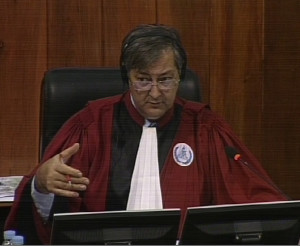
Judge Jean-Marc Lavergne
The Khmer Rouge were good at identifying people and searching for people. Thus, truckloads of people were sent away and killed. “For that reason, former Lon Nol officials died.” Five truckloads of documents were taken away, and based on these former Lon Nol officials were arrested and killed.
Judge Lavergne then wanted to know on what date these documents were assembled at the library. He replied that this was in November or December 1975. “I witnessed that the Khmer Rouge wanted to search for the former pilots and also those who were at Kampong Chhnang. Those people were sent away and killed”. People were sent to Ta Khmao Prison, which previously had been a psychiatric hospital.
Asked whether he had seen executions, he replied that “everyone only minded their businesses… I was in charge of photographing people, and they had different roles to play”. It took him five days to teach Srien on how to use the light of the camera and how to quickly take pictures.
“During the time, I was the one who developed the negatives in the darkroom. And at the time, after I developed the negatives, I could see that many many people were killed. High-ranking officials were killed, and their throats were slashed. And usually people at Tuol Sleng who had their throats slashed, mostly were part of the regiment upwards”. Judge Lavergne inquired whether he could remember the names of high-ranking officials at the time. He said that Hu Nim and other high-ranking cadres, for example Ta Khuon, had their photographs taken by Srien. Those who were from the sector committee were imprisoned. The Khmer Rouge had their special forces to be in charge of that task. He did not see the dead bodies himself, but he saw the photos of them. Sreang was part of the battalion when he was at Tuol Sleng. At the end, Sreang was also killed. He had never seen the photos of the dead body of Hu Nim.
S took photos. He had troubles recognizing some of them, since they became emaciated. Koy Thuon refused to eat. He saw negatives, but he did not see photographs of the dead bodies himself. The photos that he had developed were sent to Duch. He developed two photographs for one negative. He said that the photos looked different to those who used to be the high-ranking officials. After developing the negatives, he did not recognize them. “Those people were shot, because they were [important].” Judge Lavergne asked how he knew that the people were Koy Thuon if he did not recognize them. He replied that they came from the special prison and were dead in the photographs and had their throats slashed. Around 100 people had their throats slashed in the compound of Tuol Sleng. He was asked to develop two photos from one negative.
Ta Duch owned two houses: one in front of the Ministry of Planning. Another one was elsewhere. Two houses were merged together. Noeun went to see Duch at the house. Thus, Ta Phang and Ta Noeung would send the photos that they received from Mr. En and send them to the upper echelon. Ta Noeung and Phang were close associates to Son Sen. “Who else would they have sent the photos to?”
The President adjourned the hearing. It will continue tomorrow, April 20 2016, at 9 am with the testimony of Nhem En.
[1] E3/7618, 00164441 (EN), 0164438 (KH), 00164441 (FR).
[2] E3/7468, August 4.
[3] E3/7639, at 00162713 (KH), 00162736 (EN), 00338079 (FR).
[4] at 00162710 (KH), 0016233-34 (EN), 00338076 (FR).
[5] E3/3085R.
[6] E3/7639, at 00162740 (EN), 00162740 (FR)
[7] E3/9532, at answer 6.
[8] E3/68, at 00401819 (EN), 00162837-38 (KH), 00195658 (FR).
[9] E3/9295.
[10] E3/68, at 00401820-21 (EN), 00162839 (KH), 00195659-60 (FR).
[11] E3/5657, at 00061333 (KH), 00089778 (EN), 00347361 (FR).
[12] E3/3282 and E3/3283.
[13] E3/3282.
[14] E3/1339.
[15] E3/147, at 00679792-802 (KH) 00168465-470 (EN) 00658444-450 (FR).
[16] E3/7495, at 00826562 (KH), 00078259 (EN), 00795353 (FR).
[17] E39.4.1, P01663690-92, photos 3, 10 , 13 ,1 4, 18, 24.
[18] E3/9214.
[19] E3/135.
[20] E3/94.1 P01223788, at paragraph 178 and P0122376.
[21] E3/8639.171, E3/8639.649, E3/8639.705, E3/8639.698, E3/8639.1896, and E3/8058.
[22] P000046.
[23] E3/8063.3 at P00000015.
[24] E3/2634, at 00658495 (EN).
